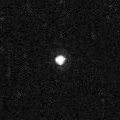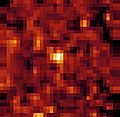(55565) 2002 AW197 facts for kids

(55565) 2002 AW197 is a large space object found far beyond Neptune. It is part of the Kuiper belt, a huge ring of icy bodies. This object is quite big, measuring at least 700 kilometers (about 430 miles) across. It's special because it's the biggest object in our Solar System that doesn't have a name yet, and it's also the largest planetoid without its own moon. Scientists at Palomar Observatory first found it in 2002. It spins around once every 8.8 hours.
Contents
How Was 2002 AW197 Discovered?
2002 AW197 was found on January 10, 2002. Astronomers at the Palomar Observatory in California made this exciting discovery. The team of scientists included Michael Brown, Chad Trujillo, Eleanor Helin, Michael Hicks, Kenneth Lawrence, and Steven H. Pravdo. They used powerful telescopes to spot this distant object.
What Is 2002 AW197 Like?
This space object is very large for something without a name. It is at least 700 kilometers (430 miles) wide. To give you an idea, that's roughly the distance from New York City to Cleveland! It's also the biggest planetoid we know of that doesn't have a moon orbiting it.
Where Does 2002 AW197 Orbit?
2002 AW197 travels around the Sun very far away. Its path is between 40.9 and 53.2 AU from the Sun. (One AU is the distance from the Earth to the Sun.) It takes a very long time to complete one trip around the Sun – about 322.6 Earth years! Its orbit is not a perfect circle; it's a bit stretched out, which scientists call having an eccentricity of 0.13. Also, its orbit is tilted by 24 degrees compared to Earth's orbit.
Images for kids
-
2002 AW197's orbit is outside that of Pluto's, with a higher inclination and different orientation
-
2002 AW197 imaged by Spitzer on 13 April 2004
See also
 In Spanish: (55565) 2002 AW197 para niños
In Spanish: (55565) 2002 AW197 para niños



